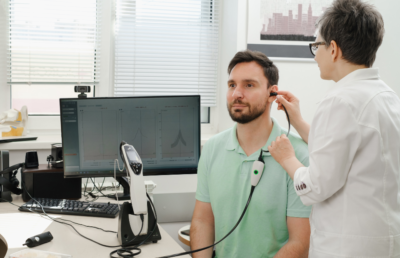On the occasion of Audiology Awareness Month in October, we’ve collected 10 interesting facts about audiology and hearing that you might not be aware of!
1. 37.5 million American adults have hearing loss
According to the National Institute of Health, approximately 15% of American adults (37.5 million) aged 18 and over report some trouble hearing.
2. Any sounds over 85 decibels can be damaging to your hearing
Exposure to any noise over 85 decibels for an extensive period of time can potentially lead to hearing loss. To put that into perspective, normal conversation is around 60 decibels, while a rock concert can reach up to 115 decibels. City traffic is about 85 decibels.
3. Audiologists can successfully treat hearing loss from start to finish
Audiologists are the experts for hearing and hearing loss care. From the diagnosis to coming up with a treatment plan, and evaluating the treatment to ensure the person with hearing loss has improved hearing capability, audiologists are involved in the entire process of treating hearing loss.
4. Audiologists deal with more than just hearing loss
Besides diagnosing hearing problems and helping you get hearing aids, audiologists can also help you prevent hearing loss, help manage tinnitus, reduce listening fatigue, diagnose and manage vestibular disorders, and diagnose and manage auditory processing issues. Most of what audiology is goes beyond a hearing test or a widget.
5. Audiologists work with all ages
Hearing loss can strike anyone, even children. While they are regularly seen working together with seniors, audiologists are trained to deal with both young and old patients.
6. Your ears are listening when you sleep
Your ears don’t stop hearing when you fall asleep. Your brain just chooses to ignore sounds that don’t seem to be threatening.
7. What you hear when listening to a seashell is not the ocean
When you place a seashell next to your ear and hear that roaring sound everyone calls the sound of the ocean, that’s actually the sound of blood surging through the veins in your ear.
8. The smallest bones in your body are in your ears
There are three bones in your middle ear that are the smallest bones in your body. All three can fit together on the surface area of a penny. They are the malleus, incus, and stapes bone.
9. Why you don’t immediately hear thunder when you see lightning
There’s often a delay between when you see lightning and hear the thunder. That’s because sound travels nearly 760 mph, while light travels about 186,000 mph. This is why you see lightning before you hear thunder—light travels a lot faster.
10. Your ears are unique
Ears are actually unique to each and every person, so much so that they are comparable in uniqueness to the fingerprint.
If you’d like to get your hearing checked, schedule an appointment to visit Chicago Hearing Services!





